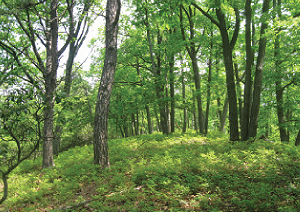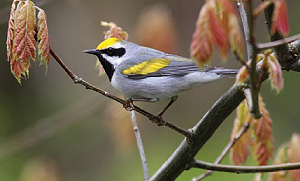Researchers, Citizens Join WPC to Support Golden-Winged Warbler Recovery

The critically threatened golden-winged warbler prefers early successional habitats for nesting.
Soon after an infestation of gypsy moths led her parents to timber a stand of damaged oak trees in the mid-1980s, Laura Jackson would see the bright yellow cap and wing bars of the golden-winged warbler popping up throughout her family’s land along Tussey Mountain in Bedford County.
Laura and her husband, Mike Jackson, figured the Neotropical migrant enjoyed the young forests that the timbering created. As the couple built a house on 113 acres that Laura inherited in 1988, it would not be unusual for Mike to see a male golden-winged warbler perched on a tall tree near shrubland; its gold head and wing markings on the background of gray, black and white plumage would be easy to spot.
But the Jacksons haven’t seen or heard a golden-winged warbler on their property near Everett, Pa., in years. The bird species is in peril, due to habitat loss and hybridization with the closely related blue-winged warbler. Pennsylvania’s population of the species has declined nearly 7 percent every year since 1966, according to Breeding Bird Survey results. The species has experienced a range-wide decline of more than 2 percent since 1966, according to the survey.
The Western Pennsylvania Conservancy is partnering with private landowners, state land managers and academic researchers to promote conservation practices that will lead to the golden-winged warbler’s recovery. Their efforts will include the protection of critical breeding habitats, management to maintain early successional conditions and population monitoring. Moreover, WPC will place the protection of the golden-winged warbler’s critical breeding habitats as a priority as it pursues land conservation projects.
According to meticulous wildlife records the Jacksons have kept over the decades, the couple usually spotted the bird in the spring and summer through the early 1990s. But by the late 90s, the Jacksons stopped seeing the warbler and only occasionally would hear its high-pitched and buzzy “zee-bee-bee-bee” song.
“By then, the habitat changed and the canopy closed up,” said Laura, who, along with her husband, has agreed to implement habitat best management practices on 25 acres of their property. “We eventually stopped seeing them and hearing them. It wasn’t a suitable breeding habitat anymore.”

A small songbird, the golden-winged warbler is often gray with a yellow cap and wing bans.
Photo courtesy of: Mikey Lutmerding
The Jacksons’ experience is not uncommon. Birdwatchers often spotted the migratory songbird as it spent its summers in the eastern and north-central portions of the United States and southern Ontario and its winters in Central and northern South America.
Now, the species is one of the most critically threatened, non-federally listed vertebrates in eastern North America. In 2010, the golden-winged warbler was petitioned for listing under the Endangered Species Act, according to Golden-winged Warbler Habitat Best Management Practices for Forestlands in Maryland and Pennsylvania, a publication written by Indiana University of Pennsylvania (IUP), Appalachian Mountains Joint Venture, American Bird Conservancy and the Pennsylvania Game Commission (PGC).
The species’ steady decline is partly due to hybridization with the closely related blue-winged warbler — the latter shares breeding habitats and competes for resources with the golden-winged warbler. When both species interbreed or hybridize, the resulting offspring (i.e., the Brewster’s warbler and the Lawrence’s warbler) share mixed characteristics of the two species.
But the loss of suitable breeding habitat is the primary cause of the species’ population decline. The golden-winged warbler often prefers high elevation and early successional habitats nestled within forested land. Think abandoned farms, reclaimed surface mines and shrub swamps.
Changes in land management practices — such as wildfire suppression – shifts in agricultural practices and the succession of young shrublands into mature forests has contributed to the loss of the species’ habitat.
Thanks to National Fish and Wildlife Foundation funding, WPC is protecting the golden-winged warbler; this work helps other organizations implement best management practices for the species. Conservancy staff, IUP researchers and land managers from the PGC and the Department of Conservation and Natural Resources are working together on this project, which will help private landowners manage habitat. The project also aims to permanently protect early successional habitats for golden-winged warblers through conservation easements and other measures.
In the future, the collaborative hopes to use data and spatial models to prioritize golden-winged warbler habitat and to use best management practices to design and implement population and habitat monitoring protocols.
At the Jacksons’ property, a forester has identified the trees that stay, the larger trees that will be cut down, vegetation that will be removed and the invasive species that will be sprayed. For the most part, workers will remove the understory — including some older trees — and will allow the bigger, healthier trees that form a canopy to remain.
While the Jacksons have mixed feelings about cutting down trees and vegetation, they believe the habitat changes won’t negatively impact other species. In fact, the cutting may be a boost to whip-poor-will populations, which generally have been on the decline across the country. This forest interior bird uses open woodlands for foraging and calling during the breeding season.
Hopefully, the Jacksons say, the golden-winged warbler will return to its rightful place in the couple’s thorough wildlife notes and observations, right next to the wild turkeys, black bears and ruffed grouse.
